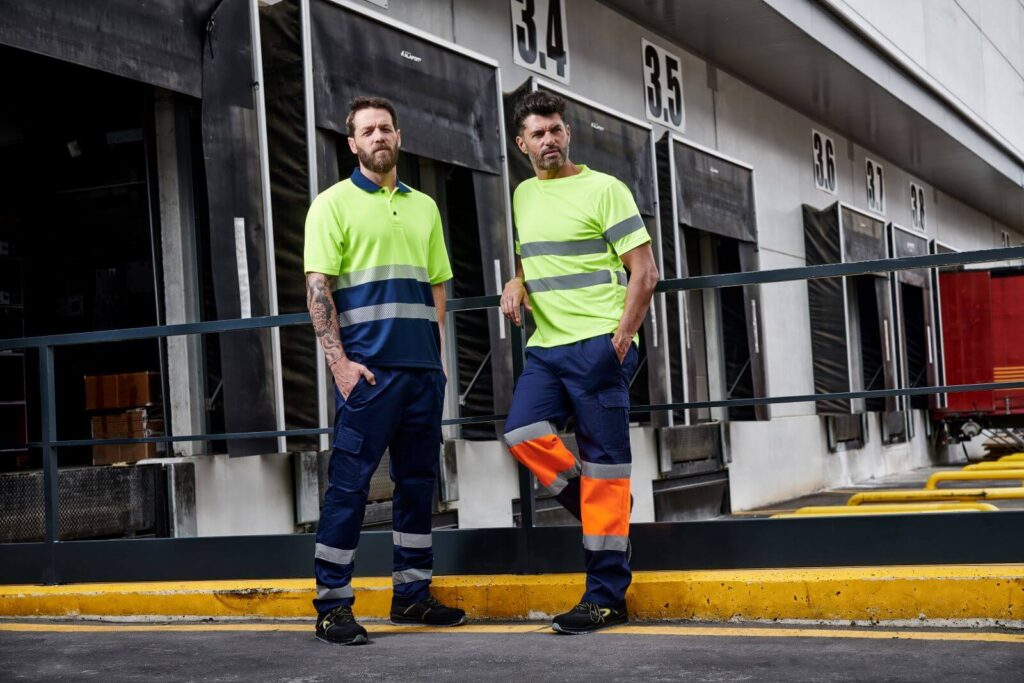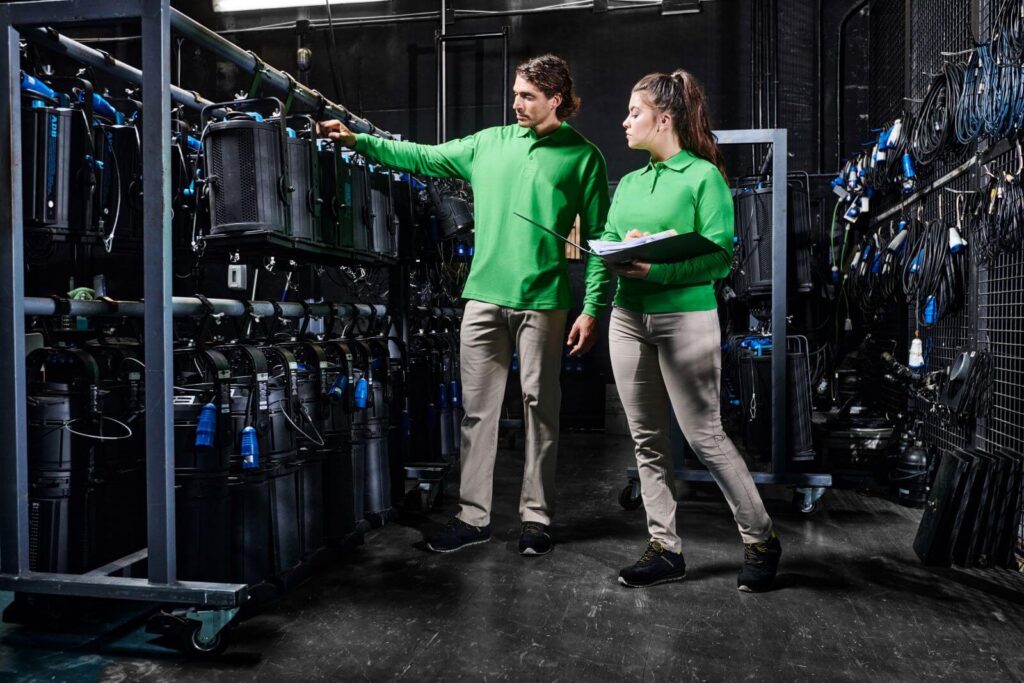In the workplace, workwear is more than just style. In fact, work uniforms play a key role in the efficient and safe running of any business. Not only do they help to visually identify employees or promote the brand, they are also essential for ensuring safety, comfort and day-to-day performance.
Whether in the construction, catering, health or industrial sectors, the right clothing protects against hazards, improves efficiency and ensures compliance with the regulations in force.
In this article, we’ll take a look at how important professional clothing can be for your company and how it can contribute to your employees’ performance.
A brief summary of the evolution of workwear over time
Let’s take a step back in time and explore the evolution of workwear. In the past, they were designed primarily for their utilitarian function, and were generally heavy and uncomfortable. The materials used, such as wool and thick cotton, had to be hard-wearing.
In the early 20th century, synthetic materials such as polyester and nylon were introduced, offering greater durability and resistance to the elements. However, these materials sometimes lacked comfort.
But today, modern workwear combines durability and comfort. Technological innovations have made it possible to incorporate lightweight, breathable fabrics, often designed to meet the safety requirements of different occupations. Brands continue to innovate by incorporating elements of contemporary fashion, including streetwear, to create functional and stylish garments.
It should be noted that this evolution is not limited to men. Women’s workwear is diversifying, with adapted cuts and modernised designs to meet everyone’s specific needs.

What impact does professional clothing have on a company’s brand image?
Workwear plays a particularly important role in how a company is perceived by its customers and partners. More than just uniforms, they convey a brand’s identity and values.
For a start, well-designed, high-quality personalised workwear reflects the company’s professionalism and attention to detail. They give an impression of serenity and rigour, which boosts customer confidence. By choosing appropriate and attractive clothing, the company shows that it cares about the appearance and well-being of its employees, which can be perceived positively by the outside world.
Workwear can also be a powerful vehicle for visual communication. The colours, logos and slogans featured on these advertising textiles can reinforce brand recognition.
They create a visual consistency between the different points of contact with customers, from the shop to the after-sales service, and even in the field. This consistency helps to reinforce the company’s image in the minds of consumers.
How can workwear improve employee productivity?
Workwear can have a significant influence on employee performance. A number of studies show that the choice of work clothing influences not only the morale of workers, but also their efficiency.
First of all, comfort is an essential factor. According to one study, over 86% of employees believe that comfortable clothing increases their productivity. If employees feel comfortable, they are less likely to be distracted by physical discomfort, allowing them to concentrate fully on their responsibilities.
Secondly, professional identity is a fundamental element. Wearing advertising or personalised clothing specific to a sector of activity can reinforce a sense of belonging and pride. A survey by the Society for Human Resource Management revealed that 65% of employees feel more involved in their work when they wear promotional clothing that represents their company. This positive identification can stimulate motivation and collaboration within teams.

Professional appearance also has a psychological impact. Wearing impeccable clothing can have a positive influence on self-perception and self-confidence. Professionally dressed employees are more likely to be perceived as competent and reliable, which can lead to better performance and more productive interactions with colleagues and customers.
Finally, the practicality of workwear should not be overlooked either. Customised clothing tailored to the specific needs of the job, such as multiple pockets for tools or robust fabrics for manual work, can significantly improve efficiency.
What are the benefits of investing in quality workwear?
Investing in quality workwear has many long-term benefits for companies and employees. These benefits go far beyond day-to-day comfort.
First and foremost, durability is a key factor. Quality advertising textiles are made from robust materials that can withstand all types of wear and frequent washing. This means fewer replacements, which reduces long-term costs. Quality advertising textiles can last for several years, offering an excellent return on investment.
Secondly, employee safety is greatly improved. High-quality workwear is designed to offer optimum protection against occupational hazards. Whether it’s flame-retardant, chemical-resistant or equipped with reflective strips for improved visibility, this equipment reduces the risk of accidents and incidents in the workplace.
Another significant benefit is comfort. Well-designed, well-fitting personalised corporate clothing allows employees to feel comfortable throughout the day, which can increase their productivity.
Investing in good quality workwear can also enhance a company’s brand image. Professional, well-maintained uniforms project an image of seriousness and professionalism. This can have a positive impact on how the company is perceived by customers and business partners.
Although it may be hard to believe, these garments are often more environmentally friendly. In fact, by opting for sustainable, quality products, companies are helping to reduce textile waste and promote responsible consumption practices.

What materials are most commonly used to make professional clothing?
When it comes to workwear, the choice of materials is crucial. The promotional fabric used must meet precise requirements to guarantee comfort, durability and protection. Manufacturers usually use specialised materials that guarantee these essential characteristics.
Cotton is one of the most popular materials for workwear. Appreciated for its great comfort and breathability, it remains the preferred choice for many professions, particularly those that require hard-wearing garments that are comfortable to wear every day.
Another popular material is polyester. This synthetic textile is known for its strength and resistance to abrasion. It dries quickly and resists stains, making it a popular choice.
In more demanding areas, cotton and polyester blends are regularly used. These blends offer the best of both worlds: the comfort of cotton and the durability of polyester. The result is garments that are comfortable to wear and able to withstand the rigours of everyday work.
And finally, for people working in high-risk conditions, flame-retardant materials are essential. Flame-retardant fabrics, often made from aramid or specially treated fibres, provide effective protection against the risk of burns from exposure to flames.
The great classics of professional clothing
Professional classics play an essential role in everyday life. These timeless, practical and elegant pieces are characterised by their versatility.
· Take T-shirts and polo shirts ꓼ made from robust cotton or technical materials, they offer absolute comfort and allow great mobility. Whether on a building site or in an office, they are ideal for environments that require flexibility and freedom of movement. A great choice of work shirts and polo shirts is the Roly brand.
· Work shirts are a combination of style and functionality. Made from durable fabrics, they are perfect for meetings or interactions with customers. These shirts remain a preferred choice for many professionals.
· Professional waistcoats are also essential. Their many pockets allow you to carry tools and accessories while keeping your hands free. Versatile, they adapt to different work environments and offer a dynamic, modern look.

· Professional sweatshirts and fleece jackets complete this range of classic garments. Promotional sweatshirts, often lined and hooded, provide pleasant warmth and are ideal for outdoor work.
· Customised soft-shell jackets offer protection against wind and moisture, while being lightweight and breathable. Their elegant design and slim fit make them a must-have for any professional wardrobe.
It has to be said that these professional quality garments, whether they are advertising T-shirts, personalised shirts or jacketsꓼ retain a timeless character that transcends fashion. They remain not only a symbol of professionalism, but also of comfort and style.
In conclusion, professional clothing is fundamental to your company’s performance and safety. By providing adequate protection, they help to reduce the risk of accidents and improve the well-being of your employees.
What’s more, the right business uniforms promote a positive brand image and strengthen team cohesion. So investing in quality customised clothing is not only a guarantee of safety, but also a lever for productivity and motivation for your company.










